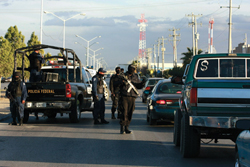Border Town Becomes Murder Capital, While Mexico Pushes for Rule-of-Law Changes

Photo by Christ Chavez
In the early morning hours of May 17, 2008, Willy Moya had just closed the V-Bar, one of several popular nightspots he owned in the Pronaf section of Ciudad Juarez, when a couple of friends wandered in and told him they were hungry. Moya decided he could use a bite, so he offered to send one of his bodyguards out for pizza.
Even in ordinary times, Moya had a few bodyguards. But this was no ordinary time in Juarez. The Mexican city of 2 million was averaging more than 100 murders per month.
Storefronts, markets and restaurants were reducing their hours or closing their doors. Lawyers, doctors, judges and policemen—even the city’s mayor—were moving across the river to the safer environs of El Paso, Texas. Married to an American, Moya had already moved to a sprawling, Spanish-style ranch home in El Paso’s Country Club neighborhood.
Moya had no real fear of the violence, according to several acquaintances. He strolled casually into the V-Bar parking lot to dispatch one of his protectors for a couple of late-night pies. As Moya walked toward his bodyguards, a small vehicle cruised by.
Shots were fired from the car in a slow-motion drive-by. Hit seven times, he was dead by the time he reached the city’s General Hospital.
Wilfredo Moya Estaco and his family had been fixtures in the nightlife of Juarez for decades. But his murder barely made news the following day. In the hours before and after his assassination, nine others were killed in far-flung parts of the city.
Three bodies were found in the Melchor Ocampo neighborhood inside an abandoned ’92 Dodge—two stuffed in the trunk, hands and feet bound. Across town in the Colonia San Antonio, a man was shot at the wheel of his Toyota bearing Texas plates. In the central business district, a man was killed at a gas station. A 29-year-old shopkeeper was found, his throat slit, inside his store. A couple cruising in their late-model Mercedes were hit with bullets from an AK-47 as they slowed for a stop sign.
The months of murders were attributed to a turf war between drug cartels. Two thousand people were slaughtered in a little more than a year. The killings took place at all hours and in every gruesome way imaginable. Some were tortured or burned or mutilated. Bodies were dumped in empty lots, in school yards, beneath bridges.
THE LOCKDOWN
By the first week of March of this year, the Mexican government mobilized 3,200 federal troops, placing the city, in effect, under martial law. Soldiers patrolled the streets, watched the border crossings, manned the dispatch boards and typed police reports. The local police department, corrupt and incompetent, was dismissed and replaced with new officers with no ties to Juarez—or former officers who would pass lie detector tests.
The killings slowed almost immediately to a trickle, and an uneasy quiet returned to the streets of Ciudad Juarez. At least for a time.
But even as the narco-violence was on the rise, the situation was more complex than the screaming headlines would lead one to believe. There were changes afoot, both worrisome and encouraging, in the culture of Juarez.
Much of the violence, according to lawyers and other observers, was the result of mere thugs taking advantage of a community destabilized by the drug wars and burdened by a justice system that lacked public trust.
But even as the body count rose, in courtrooms and prosecutors’ offices there was hope that a profound transformation of the Mexican justice system now under way may help the police and courts act as a bulwark the next time crime begins to spin out of control.
Click here to read the full story online from this month’s ABA Journal.



